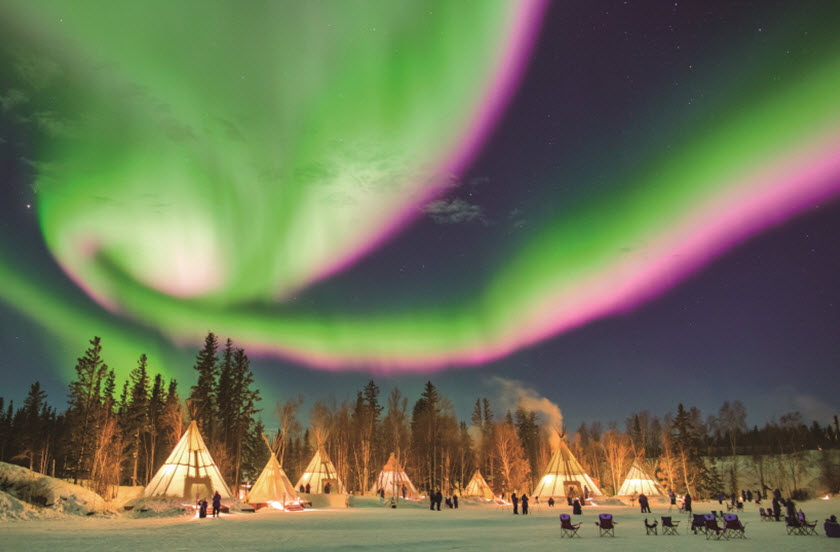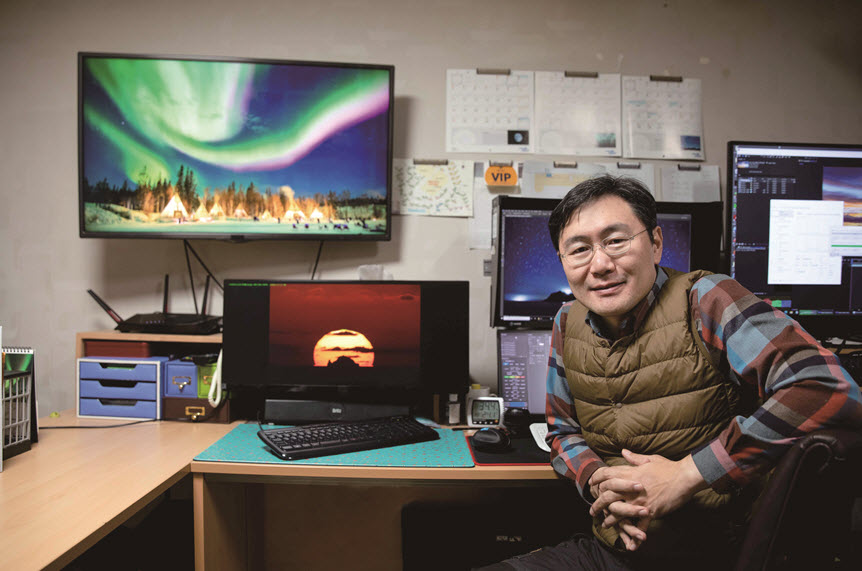“Before this vast universe, we realize our existence is ultimately meaningless. We are but specks of dust in this universe. So, if I am, too, just another speck of dust, I choose to be a contented one.” These are the words of O Chul Kwon (matriculating class of ’92), who introduces himself as the first-ever astronomical photographer in the nation. In his pioneering efforts, he has been recognized for his being featured on NASA’s Astronomy Picture of the Day and his contribution to the initiative titled, The World At Night (TWAN), designated by UNESCO and the International Astronomical Union (IAU) to capture the universal night sky from historical and cultural locations worldwide. SEE sat with him to hear more about his story of how he looked to the stars for answers when embarking on a journey exclusively his own, in pursuit of a faraway beauty.

Canada Teepee and Aurora, photographed by O Chul Kwon
South Korea’s first professional astronomical photographer After graduating from the Department of Naval Architecture and Ocean Engineering, Kwon started work in submarine design at a major firm and later transitioned into software development at a venture capital firm. In 2010, he left his job to pursue his passion for astronomical photography full-time. The past decade, however, has been a period of thorough preparation for this practice, which he describes as an amalgamation of art and science: “It has mostly been a waiting game. I have continuously been keeping an eye out for the latest advancements in technology while exploring the various potential takes and calculating the optimal conditions for photographic success. The odds of my uncertain future made this period of preparation just that much more crucial.”
The diverse technologies Kwon uses include film photography, digital photography, time-lapse photography, and Virtual Reality (VR) photography and videography. He says still photography alone is not sufficient to capture many astronomical phenomena, such as auroras, due to their highly obscure movements. After persistent experimentation — sometimes for weeks camping out in weather that is 40 degrees Celsius below zero and experiencing technology shut down from the cold, he was able to become the first in the world to capture an aurora completely, using VR photography and videography.
A science communicator of his own
His later efforts consisted of extending this project by adding more context and content for the public. He first released the original VR footage of an aurora, appending his own commentary, and in 2019, he released a short film titled, Cosmos Odyssey: Our Quest to Discover the Universe, showing, through a compilation of various footages, a visual history of astronomy. As a complement to the film, he published a book titled, O Chul Kwon’s Cosmos Odyssey, which included more elaborate explanations and direct references to parts of the film via QR codes. Kwon says that in pairing the film and book he hoped not only to provide greater accessibility, but also that the combination of the two mediums might induce a greater curiosity for astronomy in the public. He emphasizes the flexibility and potential, and at the same time the responsibility that comes with being a pioneer in this domain: “As the first full-time astronomical photographer in South Korea, I am trying to define the scope of its domain. If a scientist is a person who investigates into areas of undiscovered knowledge, then a science communicator is one that informs the public of this new knowledge. That makes me then a science communicator of the visual domain.” He adds that it is in his personal calling “to convey the wonders of the night sky and share with others that feeling of marvel.”
Confirming the Sejong Sillok Jiriji
A record in Sejong Sillok Jiriji (the geography section of the Annals of King Sejong’s Reign), reads as follows: “The two islands, Usan [Dokdo] and Mureung [Ulleungdo], are in the middle of the sea, due east of the country (Uljin). Not far apart from one another, each island can be seen from the other side on a clear day.” The fact of the matter is that the Japanese administration had long obscured this record, claiming that a distance of 87.4 km was maintained between Dokdo and Ulleungdo — a distance too large to be able to identify each island from one another.
Kwon, however, in just one photograph, which he took of the Dokdo sunrise from Ulleungdo, managed to put an end to the age-old historical dispute. It was, indeed, an outstandingly serendipitous achievement, realized just a year before the 70th anniversary of Korean liberation from Japanese rule — and an achievement that was possible exclusively due to Kwon’s innovative photographing abilities of meshing the latest technology and engineering. “I was watching the sunset one day from Dokdo when I noticed the sun moving toward Ulleungdo. So, I became curious how Ulleungdo would appear from Dokdo — for if Dokdo were visible from Ulleungdo, the reverse would then be true. And I began my calculations.” Kwon simplifies the math as follows: “the angular distance of the sun when calculated from Dokdo being 0.5 degrees, and the angular distance of Dokdo when calculated from Ulleungdo being 0.3 degrees, if one is able to find the date and location at which Ulleungdo, Dokdo, and the sun achieves alignment, then they will be able to capture the sun rising behind Dokdo.”
Kwon recalls the problems he encountered in the process of reaching this formula: “I had overlooked the fact that the earth is round and later understood that this makes Dokdo not very visible from sea-surface level. From this understanding, I applied the trigonometric functions and was able to determine the precise points for the perfect capture. And in that position, I waited for the sun to rise, again and again. Three years later, I had the capture I was looking for.”

O Chul Kwon (Alumnus, Department of Naval Architecture and Ocean Engineering), Astronomical photographer
Dissatisfaction as a driving force
“When my photograph of a location is made known, the location becomes famous. It appears that even now, there are photographers that line up to take photos at the location that I found to be favorable for capturing the Dokdo sunrise. And that is what makes my efforts original and meaningful — by being the first to have done it. For there will always be someone that takes a better photo from the second try onward.” Kwon further describes a constant dissatisfaction with results as being what pushes him to strive for constant progress: “I do not think that I am ever satisfied, and I think that settling for the status quo is tremendously dangerous. It is like how Genghis Khan, in his last words, invited his followers to take up the challenge of extending his empire to the whole world. So, rather than trying to keep up with the trends of the times we should find our own thing — our own calling — and commit to it wholly, while maintaining an attitude of constantly challenging ourselves. In photography, this would mean getting as clear as possible on what it is you are trying to produce, convey, and creating opportunities for yourself to do it.”
Kwon will be screening more of his edited footage at a science museum later this year. He will continue to pursue his life’s project, challenging himself with new mediums and techniques, to share a beauty that only a select few have the endurance to truly capture.
Written by Jeeye Hong, SNU English Editor, hongjeeye16@snu.ac.kr
Reviewed by Professor Travis Smith, Department of Asian Languages and Civilizations, tlsmith@snu.ac.kr

